Baseball Movies, Visualized – Hardball Times

There’s nothing like a good baseball movie.
A few weeks ago, Alexandra Simon launched a retroactive review series here at The Hardball Times with a wonderful review of Sugar (2008), one of the very few baseball films I hadn’t seen. The most eye-popping line for me in Simon’s review was that Sugar registered at 92 percent on Rotten Tomatoes. That Rotten Tomatoes score places the film in some elite company, baseball film or otherwise.
After watching the impressive film, I then went down the rabbit hole of determining where Sugar fits in the larger context of all baseball movies. What I’ve developed is an infographic that breaks out baseball films by year, the top 10 baseball films both at the box office (all figures adjusted to 2015 dollars) and on Rotten Tomatoes, and a scatterplot that compares each film’s two categories.
My first step was finding a reliable list of baseball movies. Baseball Almanac has a very thorough list, which I used as my starting point. From there, it was a matter of culling the list, determining which films have box office data available. Box Office Mojo supplies plenty of data, so it served as my data source for box office figures.
Unfortunately, box office information is very limited prior to 1980, appearing only on a case-by-case basis. For instance, Box Office Mojo had figures for the three pre-1980 Bad News Bears movies but did not for 1973’s Bang the Drum Slowly. As such, the sample set presented here does not go back prior to 1976. Unfortunately, this means all-time classics like The Pride of the Yankees, The Jackie Robinson Story, and Fear Strikes Out could not be included. This also means films that did not receive a theatrical release (HBO’s 61* and Soul of the Game, for instance) did not make the cut.
Once I had my starting list and eliminated films without box office data, the next step was collecting fresh and rotten voting totals for my sample set on Rotten Tomatoes. The final step was a little tricky. I had to eliminate certain films from the Baseball Almanac list. Several movies on the list included baseball scenes, but would not be considered “baseball” movies. There’s no objective way to do this, so it involved my own personal judgment. Examples of these types of movies: City Slickers, My Dog Skip, Ferris Bueller’s Day Off, Taking Care of Business and Naked Gun. I love many of these films for providing contributions to the baseball-on-film canon, but it would be a stretch to define them as movies about baseball.
This completed my full set, leaving me with data for 52 films since 1976. Here is how these films fall into place in the big picture.
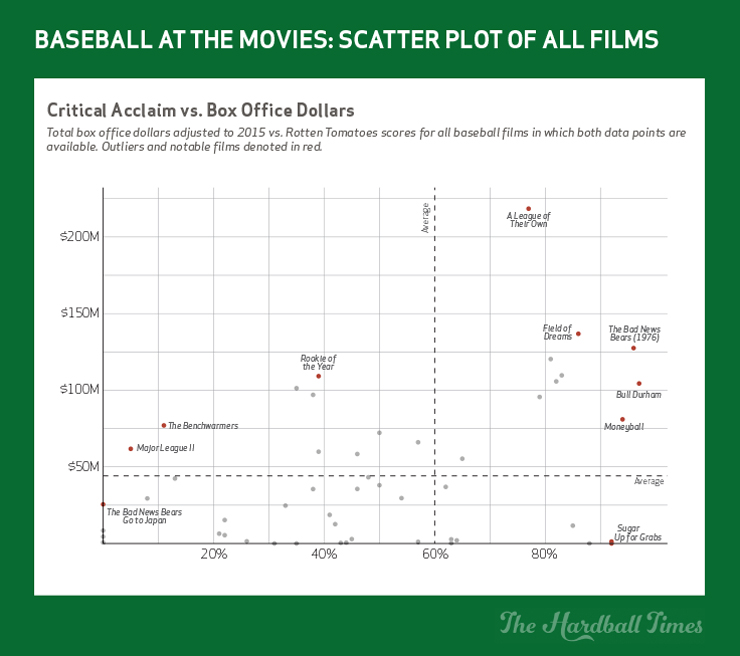
The scatterplot highlights outliers from the four quadrants and the most popular films, but we will revisit each quadrant — complete with each movie in the sample set — momentarily.
Next let’s break things down by year.
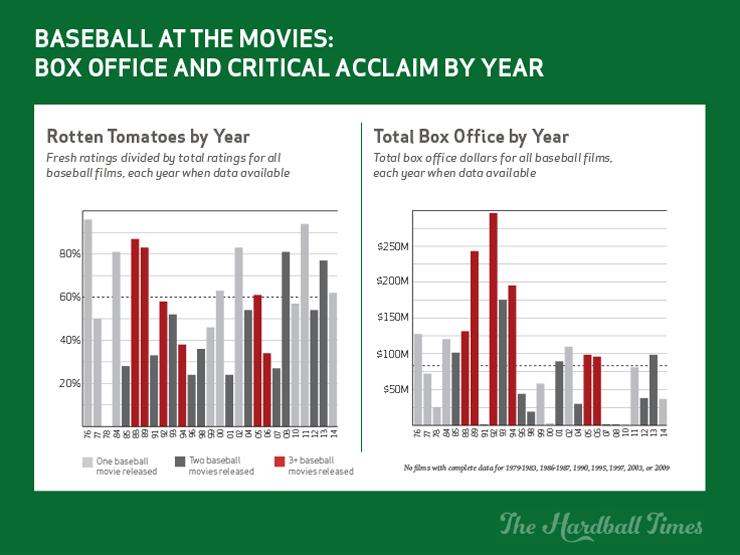
One of the first things that leaps out is verification of what I’d always suspected. The 1988-1994 period, and specifically 1988-1989, was the golden age of baseball of the movies. Let’s call it the Shelton-Costner effect, named for director Ron Shelton (Bull Durham, Cobb) and Kevin Costner (Bull Durham, Field of Dreams) — the Ingmar Bergman and Max von Sydow of baseball movies. Eighteen of the 52 films — 34.6 percent — come from the 1988-1994 window.
Finally, let’s take a look at the top 10 lists:

The 1988-1989 window provided us with the Nos. 1, 7, 8 and 10 films on Rotten Tomatoes, as well as the Nos. 2, 7 and 8 in terms of box office totals. Expand the window to 1988-1994 and you can add the Nos. 1, 6 and 9 films to the box office list, and Nos. 13 and 15 to the RT list. The top five years for aggregate box office are 1992, 1989, 1994, 1993 and 1988.
Add it all up and 45.4 percent of all money spent on baseball movies at the box office since 1976 was spent in the 1988-1994 window. And none of this is skewed by years with only one film. Six of the seven years in the golden age featured two or more baseball movies There are only 17 years in the sample that satisfy that condition.
Now, let’s look at each individual quadrant of the scatter plot. For fun, I’ve named each quadrant after a baseball player who best represents each category. As it turns out, the average baseball movie (using all fresh ratings for the sample, divided by the total ratings for the sample) just happens to be 60 percent. That’s the exact threshold RT uses for its own fresh/rotten designation. The average box office for the sample is $44.18 million.
The Adrian Beltre Quadrant: Lots of Quality, Lots of Money
These are the films that excel both at the box office and in terms of critical acclaim. Like Beltre, these movies acquired a lot of money and provided very high quality in return. This category is where three films begin to stake their claim to the tile of the best baseball movie ever made — at least adhering strictly to our two very specific categories: Moneyball, Bull Durham and The Bad News Bears. Other films earned more at the box office, but none trumped their combination of critical acclaim and box office dollars.
Also apparent in this quadrant is the smashing success A League of Their Own had at the box office. For some perspective, the second-highest box office total comes from Field of Dreams, and it registers only 62 percent of the box office total of A League of Their Own. There’s no crying in baseball, but there are tears at the box if you’re a baseball movie hoping to compete with 1992’s hit. Fever Pitch also appears in this quadrant, which is somewhat of a shocker, but I’d rather just pretend it’s not there.
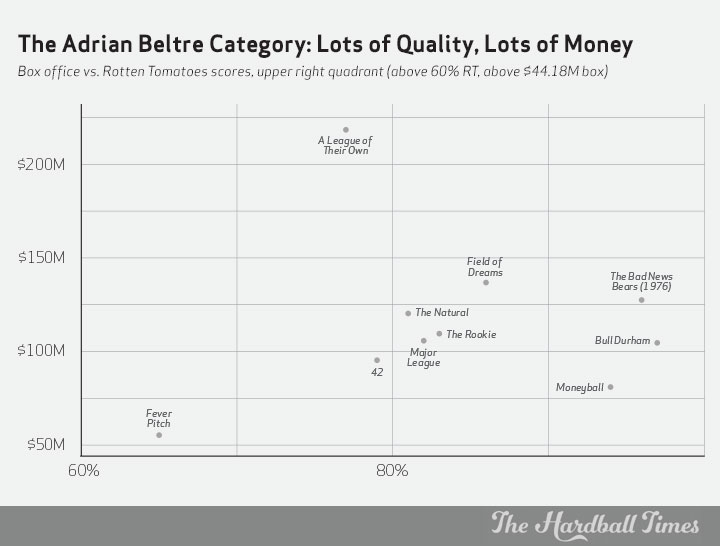
The Ben Zobrist Quadrant: Lots of Quality, Limited Money
This offseason’s contract notwithstanding, Zobrist has provided 36.8 WAR in his career while collecting a scant $30.8 million. Like Zobrist, movies in this quadrant also supply a ton of quality without earning much money. It includes Alexandra Simon’s champion, Sugar, as well as my own personal favorite, Eight Men Out. Two other rather obscure films assert their high quality in this category, Ballplayer: Pelotero and the 2004 documentary, Up for Grabs. Shelton also strikes again in the Zobrist category, just barely, with Cobb coming in at 64 percent. Similarly, Million Dollar Arm starring Jon Hamm barely makes the grade at 62 percent. Just a few million dollars more at the box office and it would be a Beltre film.
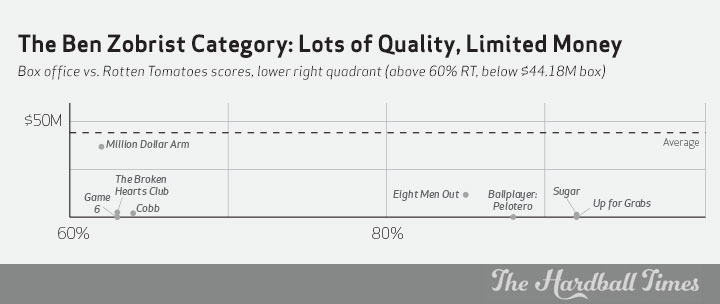
The Vernon Wells Quadrant: Little Quality, Lots of Money
Wells’ seven-year, $126 million contract stands as one of the worst in recent memory, attributed to the fact that Wells provided little value for the large volume of money he was given. Such is the case with this quadrant. There are some fringe performers here — some beloved movies (The Sandlot), plenty of perfectly fine movies (For Love of the Game) and some family-friendly fare (The Bad News Bears in Breaking Training, Angels in the Outfield, Rookie of the Year). But for whatever reason, their critical acclaim doesn’t match their box office clout. The true dud of the bunch — the equivalent of Wells’ $26 million, 0.3 WAR season — is Major League II (with an appalling five percent RT score), the movie that essentially closed the door on the golden age of baseball movies in 1994.

The Aaron Miles Quadrant: Little Quality, Limited Money
Every team has a bench, or role, player who drives the home team fans batty. This player doesn’t occupy much playing time and does very little with opportunities when they happen. These players rarely make much money. In other words, these films profile as Aaron Miles — mediocre and occasionally putrid quality but not much box office damage. This quadrant encompasses the most films.
The sheer number of movies in this quadrant perhaps explains why there aren’t more baseball movies to sate our appetites. A whopping 46 percent of all baseball movies fall below $44 million at the box office and below the 60 percent rotten threshold on Rotten Tomatoes. But just like the Wells category, it’s not all doom and gloom. For instance, The Perfect Game is just a few percentage points away from qualifying in the Zobrist/underrated gem category. It’s one of the first movies I recommend when people ask for lesser-known baseball options that won’t disappoint them, particularly family-oriented movies. The Scout will drive baseball purists crazy, but it’s acceptable fare if you’re an Albert Brooks completist. Of course, this group also possesses the worst of the worst, total bombs both at the box office and with critics. I’m looking at you, Ed.
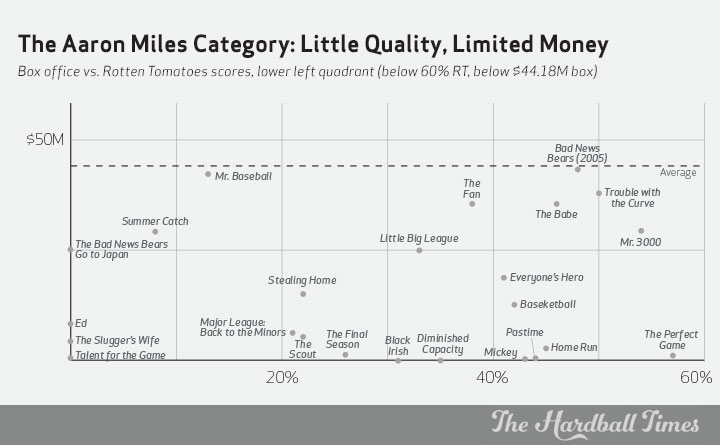
These quadrants are all well and good, but it’s important to remember one thing about all of these movies. They were made to be enjoyed. Whether or not a movie was successful at the box office or achieved critical acclaim is irrelevant if you enjoy watching it. If you’re a baseball fan — and if you’re reading The Hardball Times, you surely are — there is at least one aspect you can enjoy in every movie on the scatter plot. Aaron Miles may be tough to watch, but he’s better than no baseball at all.
References & Resources
- Alexandra Simon, The Hardball Times, “Retroactive Review: Sugar”
- Baseball Almanac, “Baseball Movie Checklist”
- Rotten Tomatoes
- Box Office Mojo




